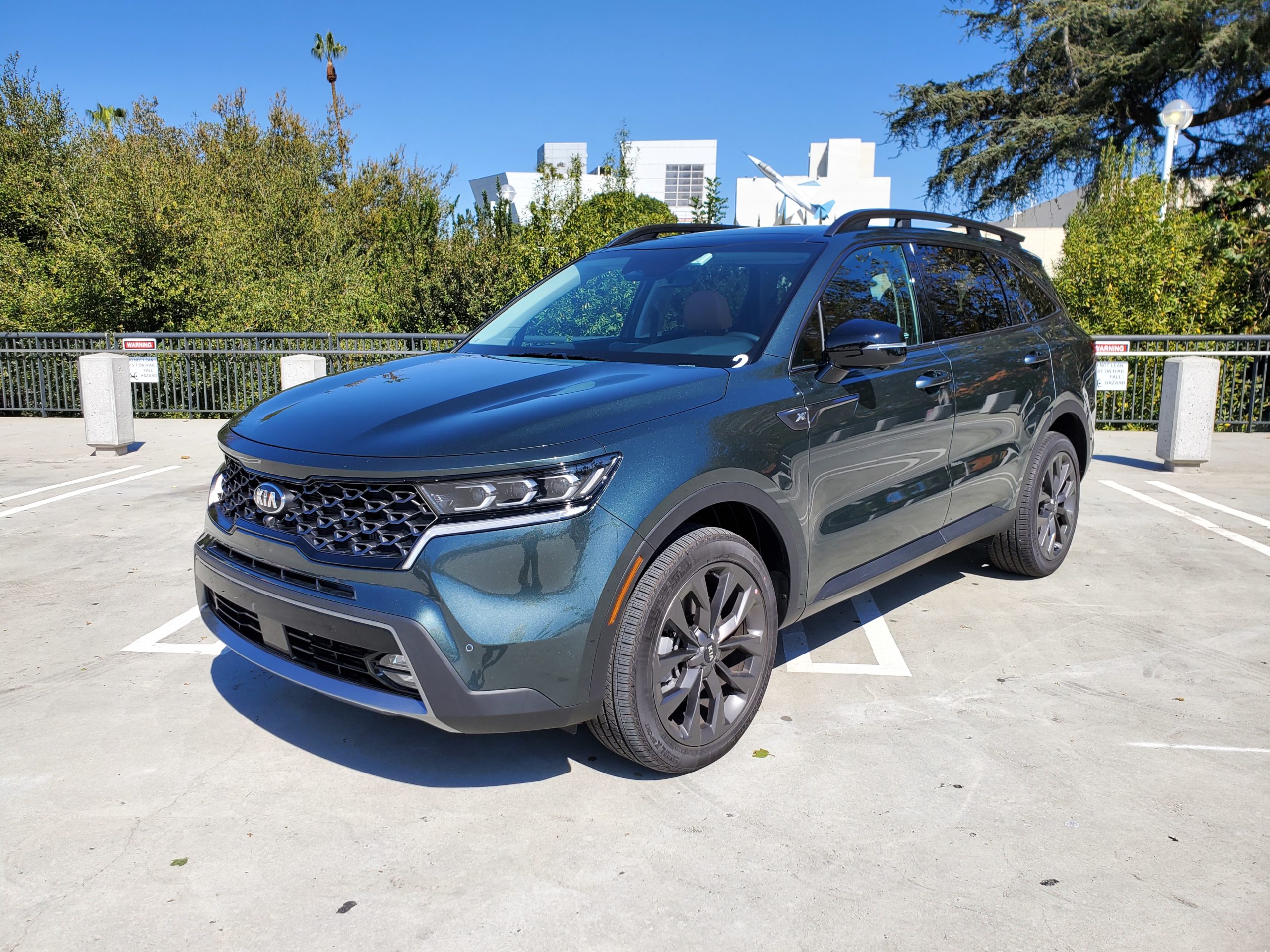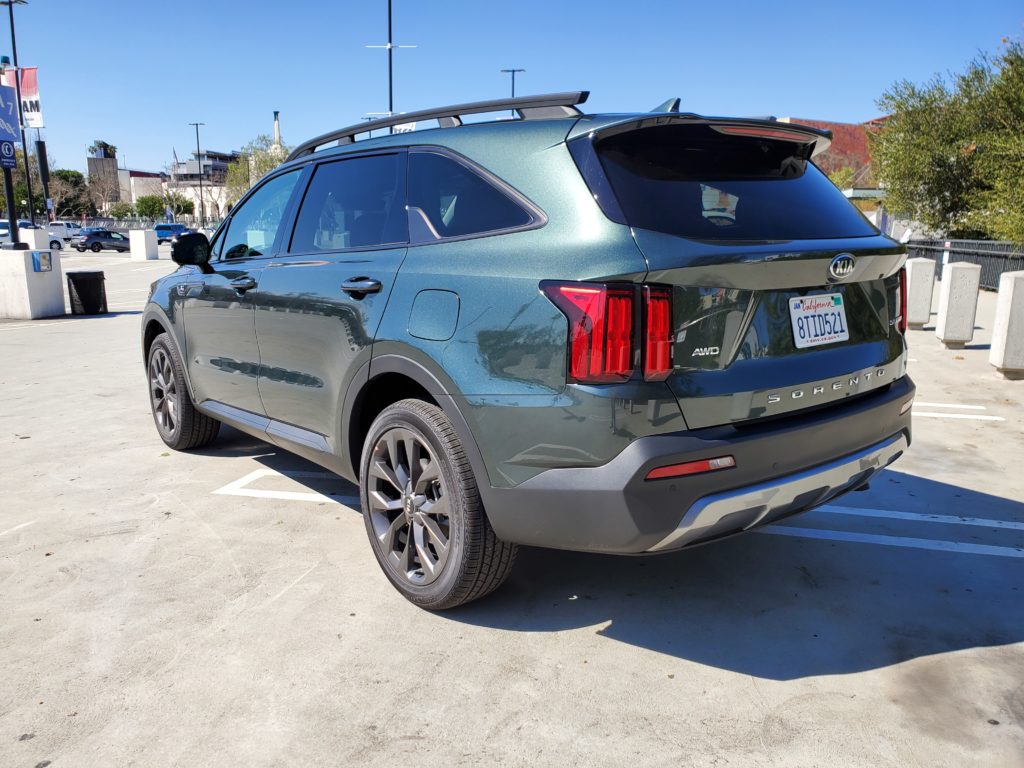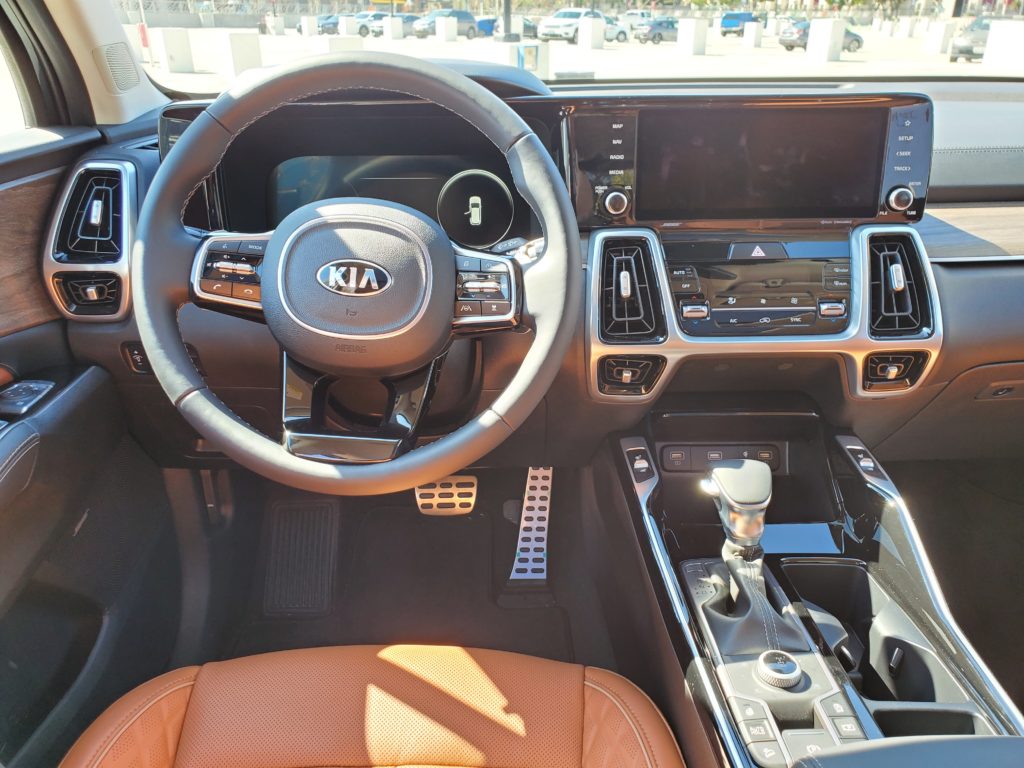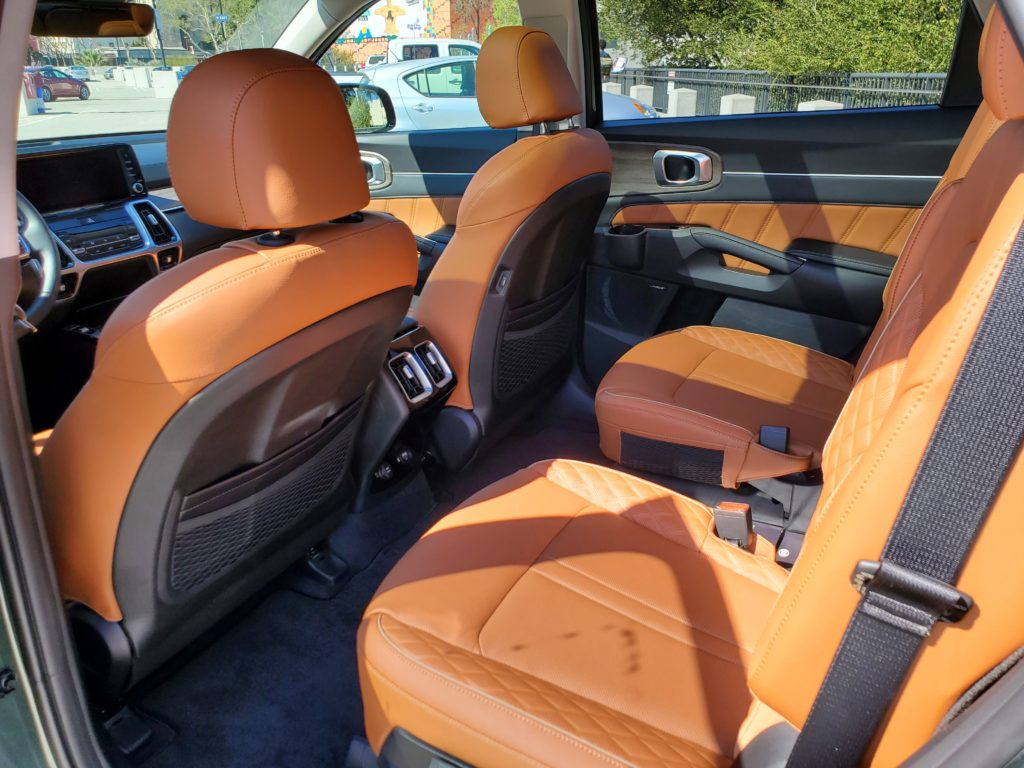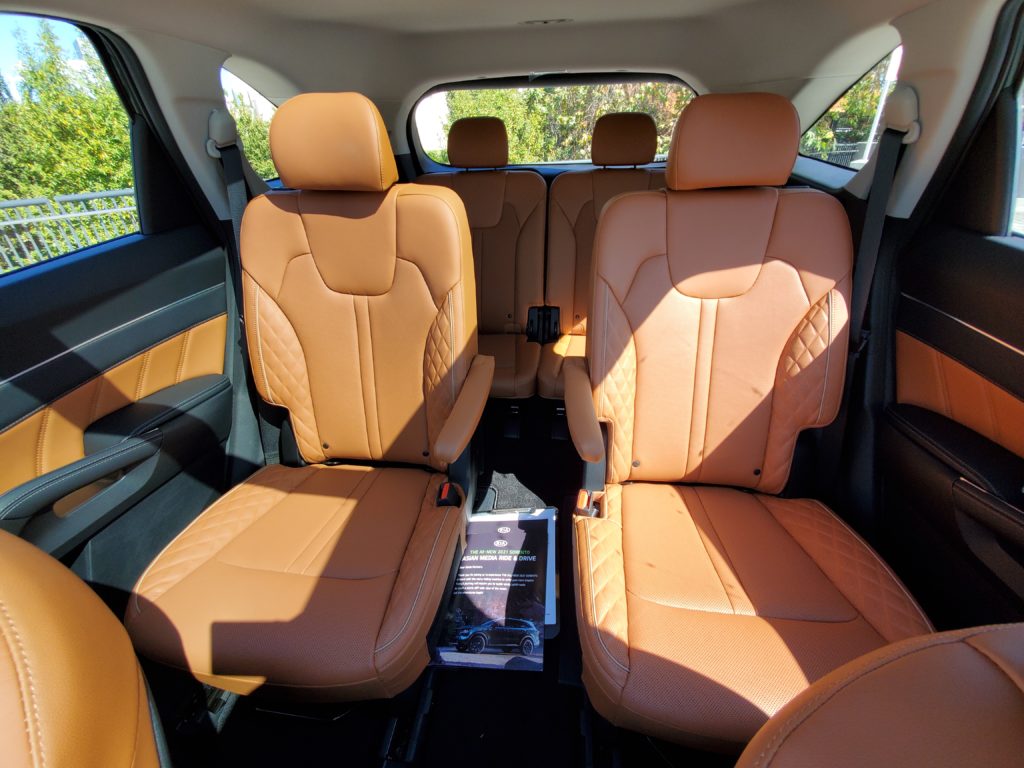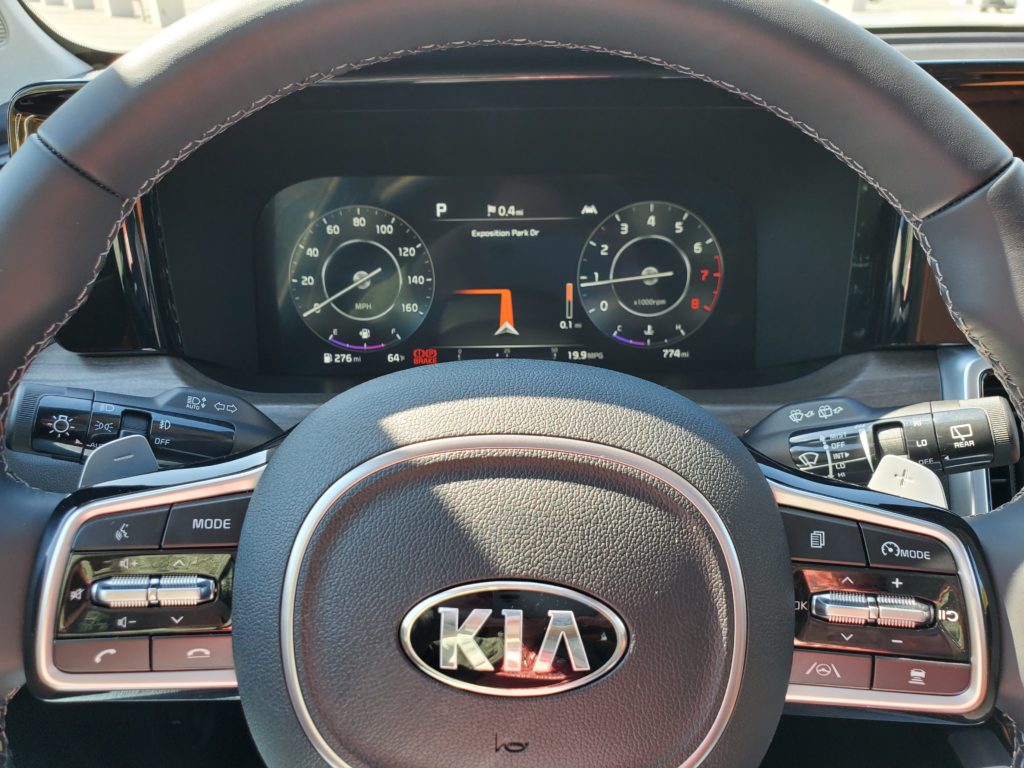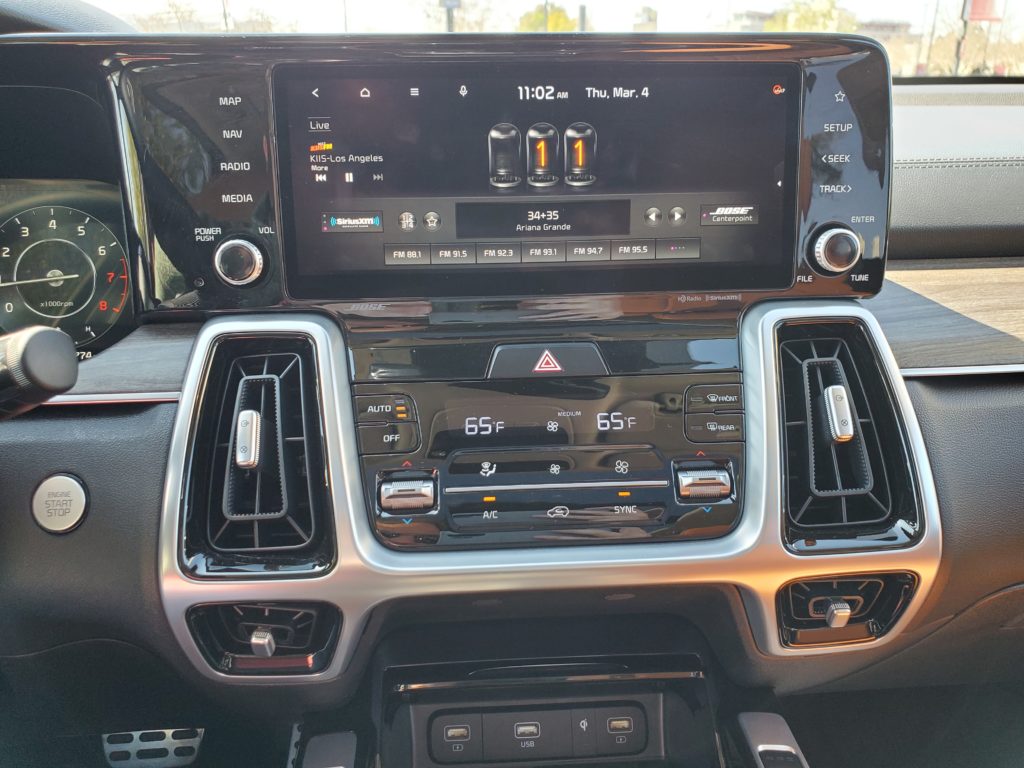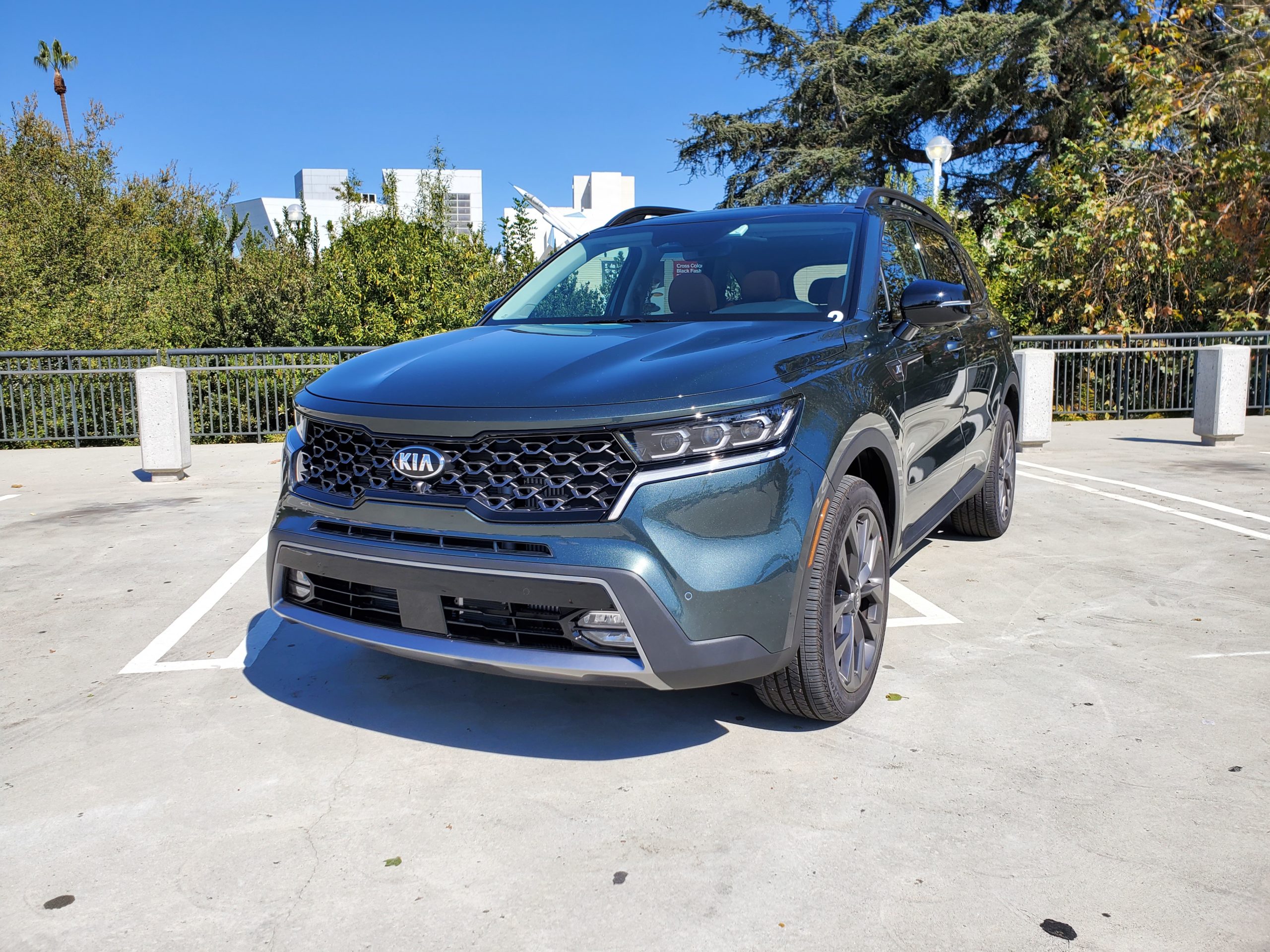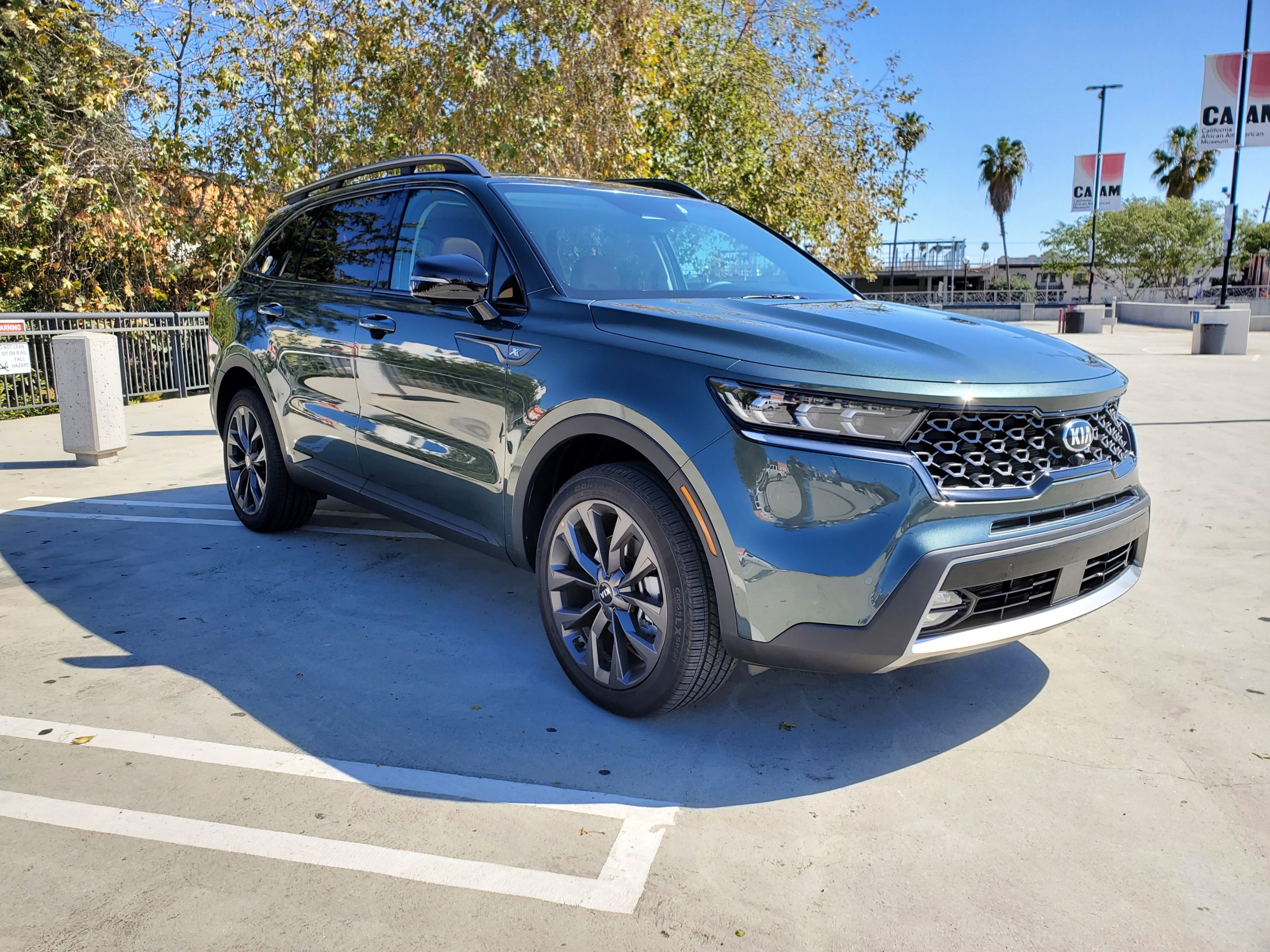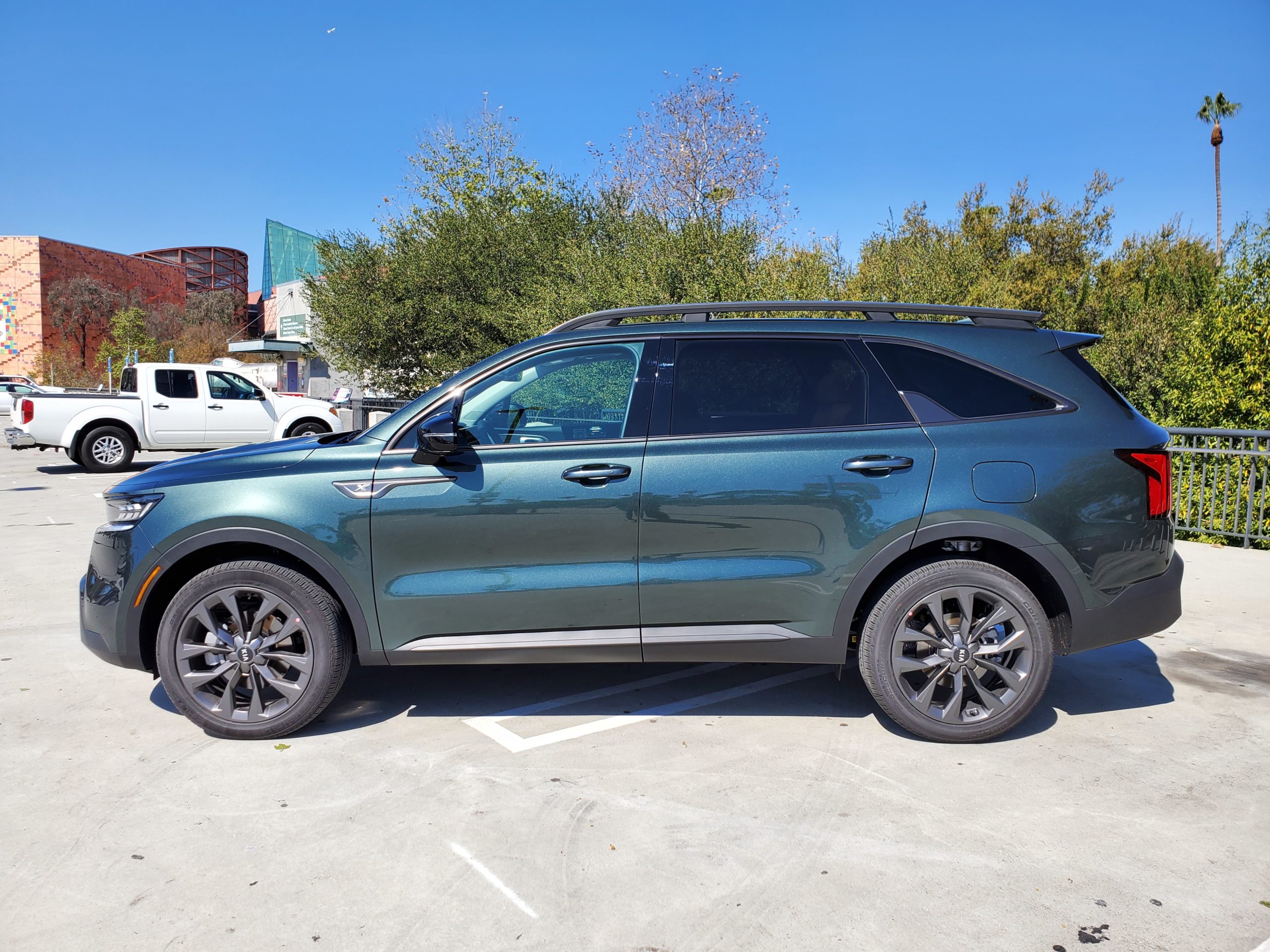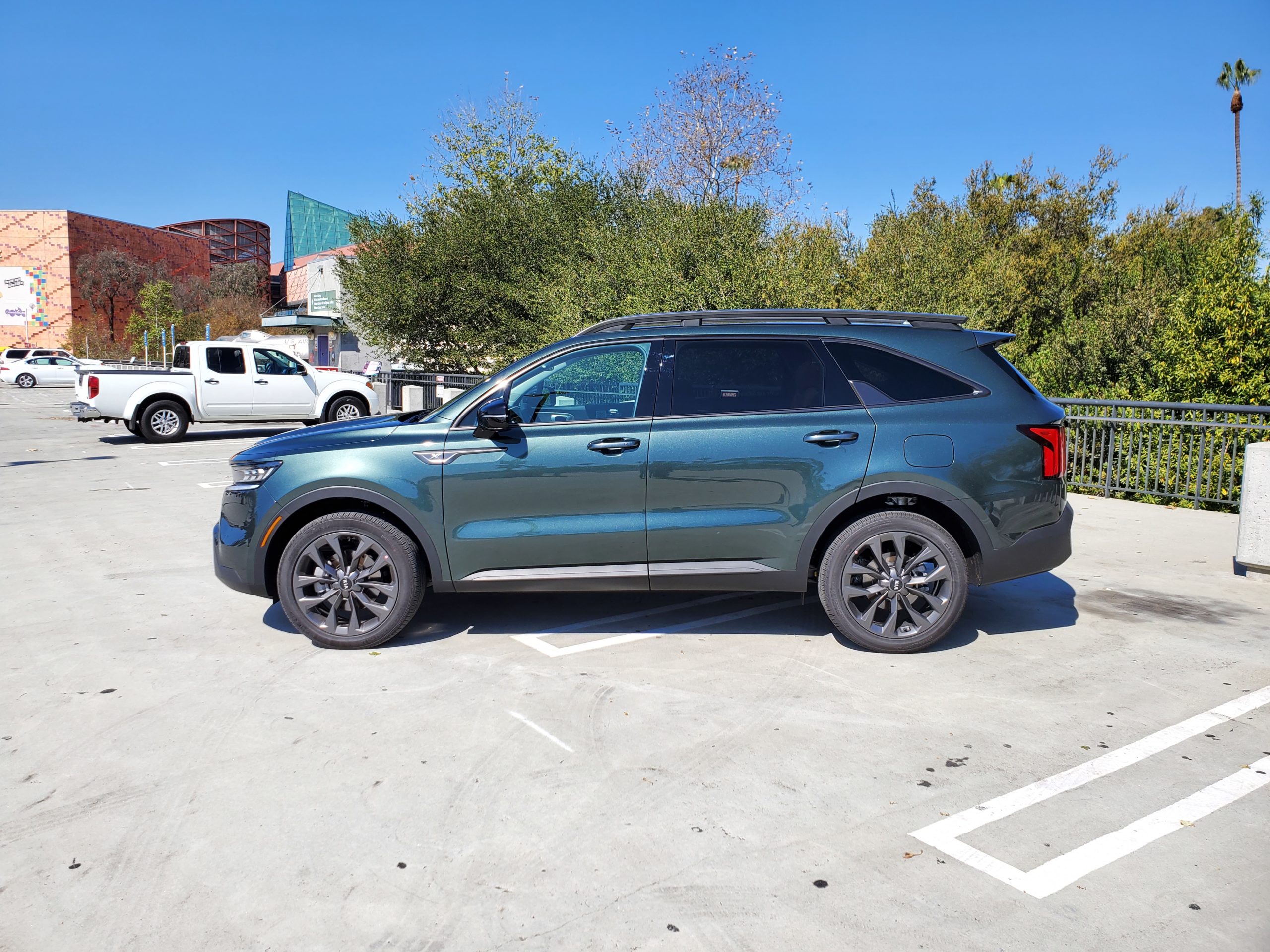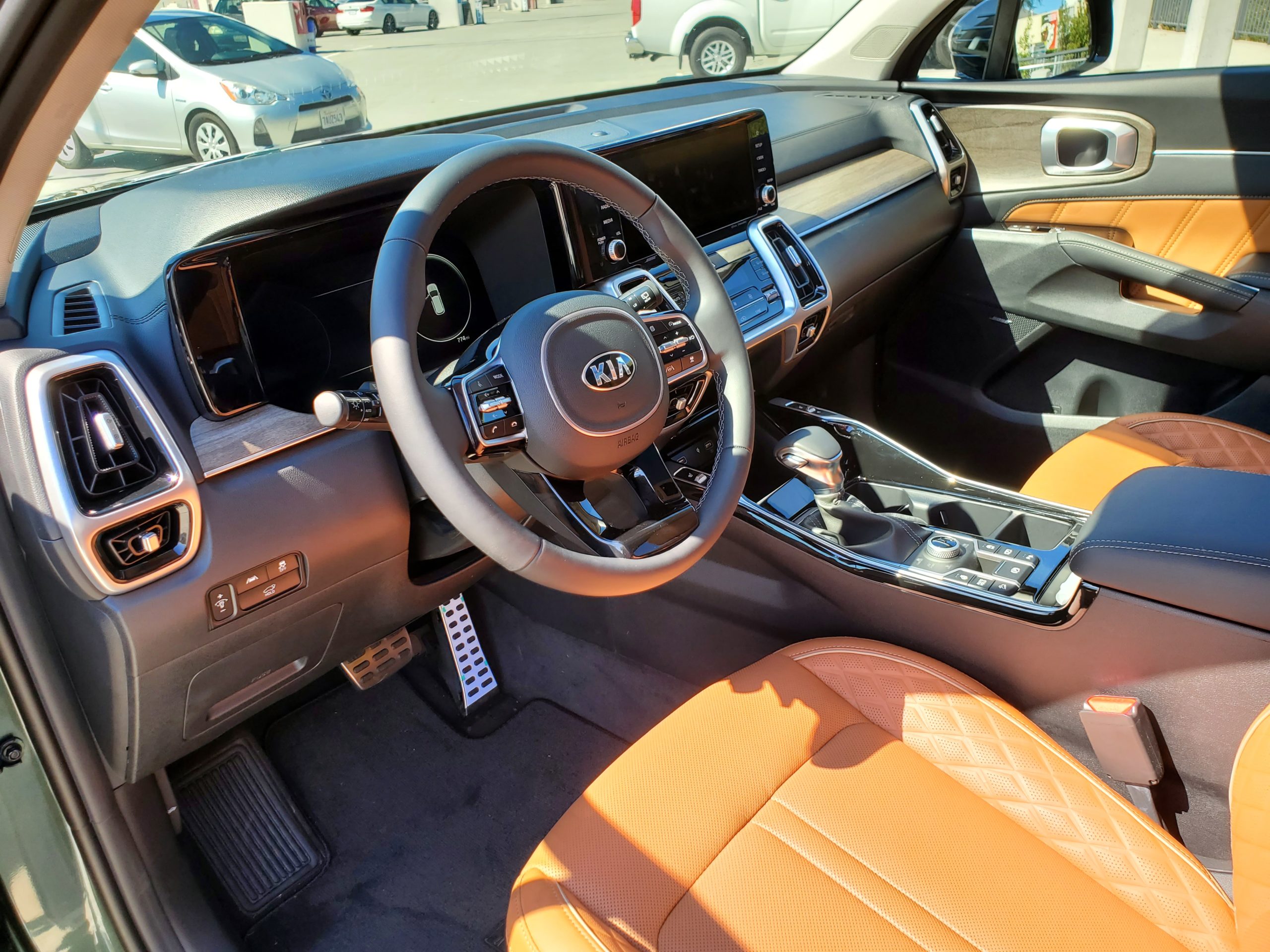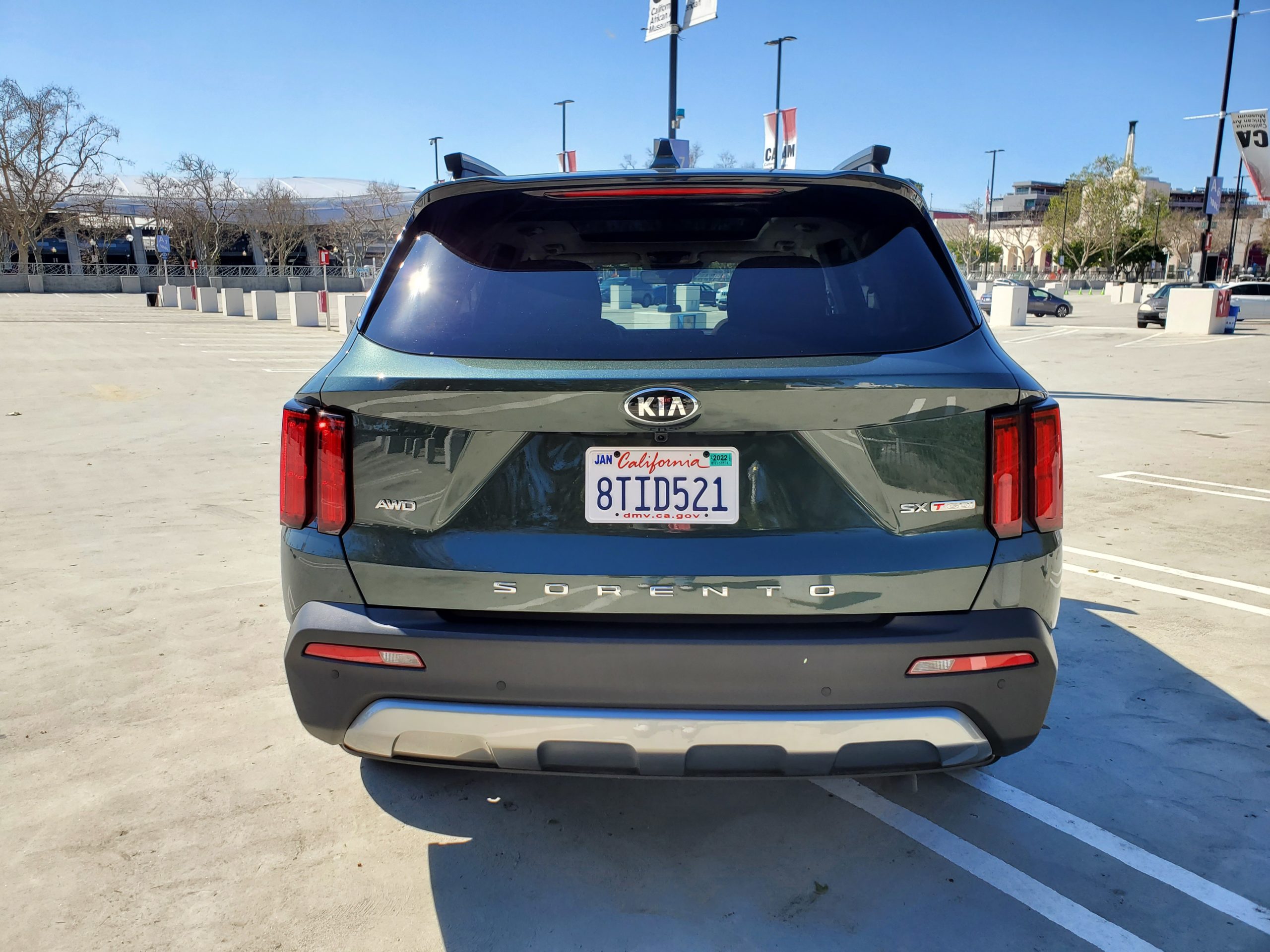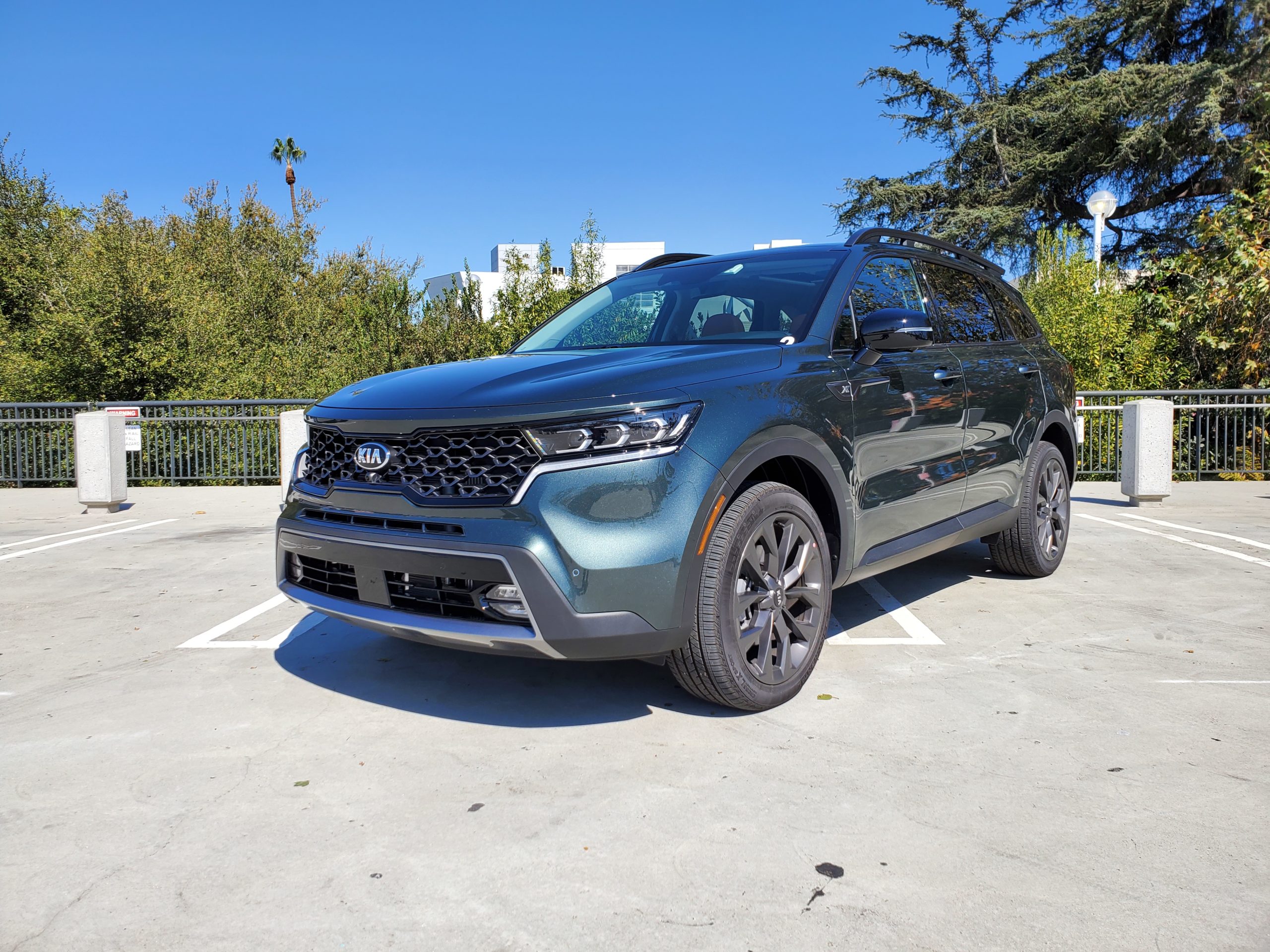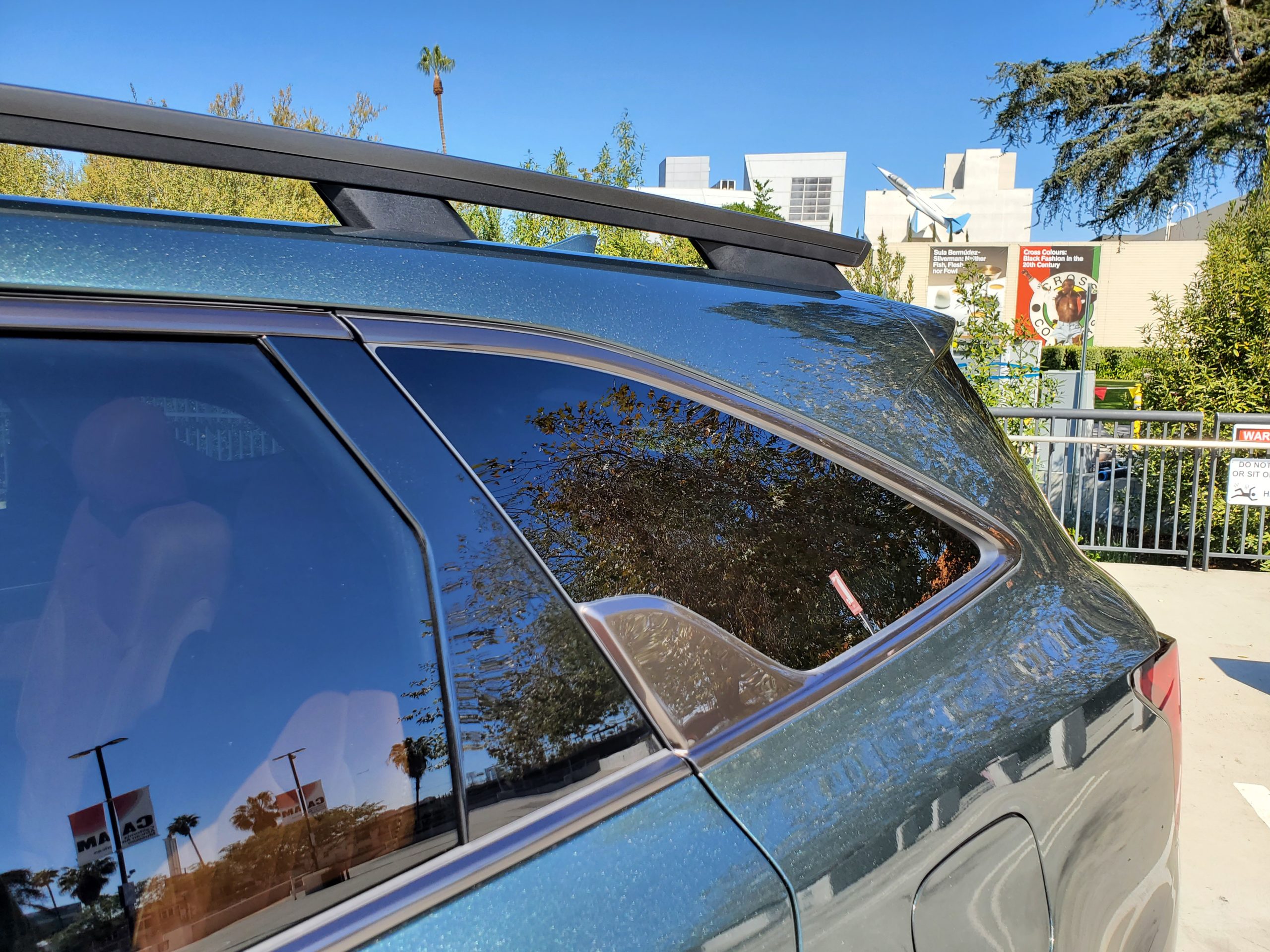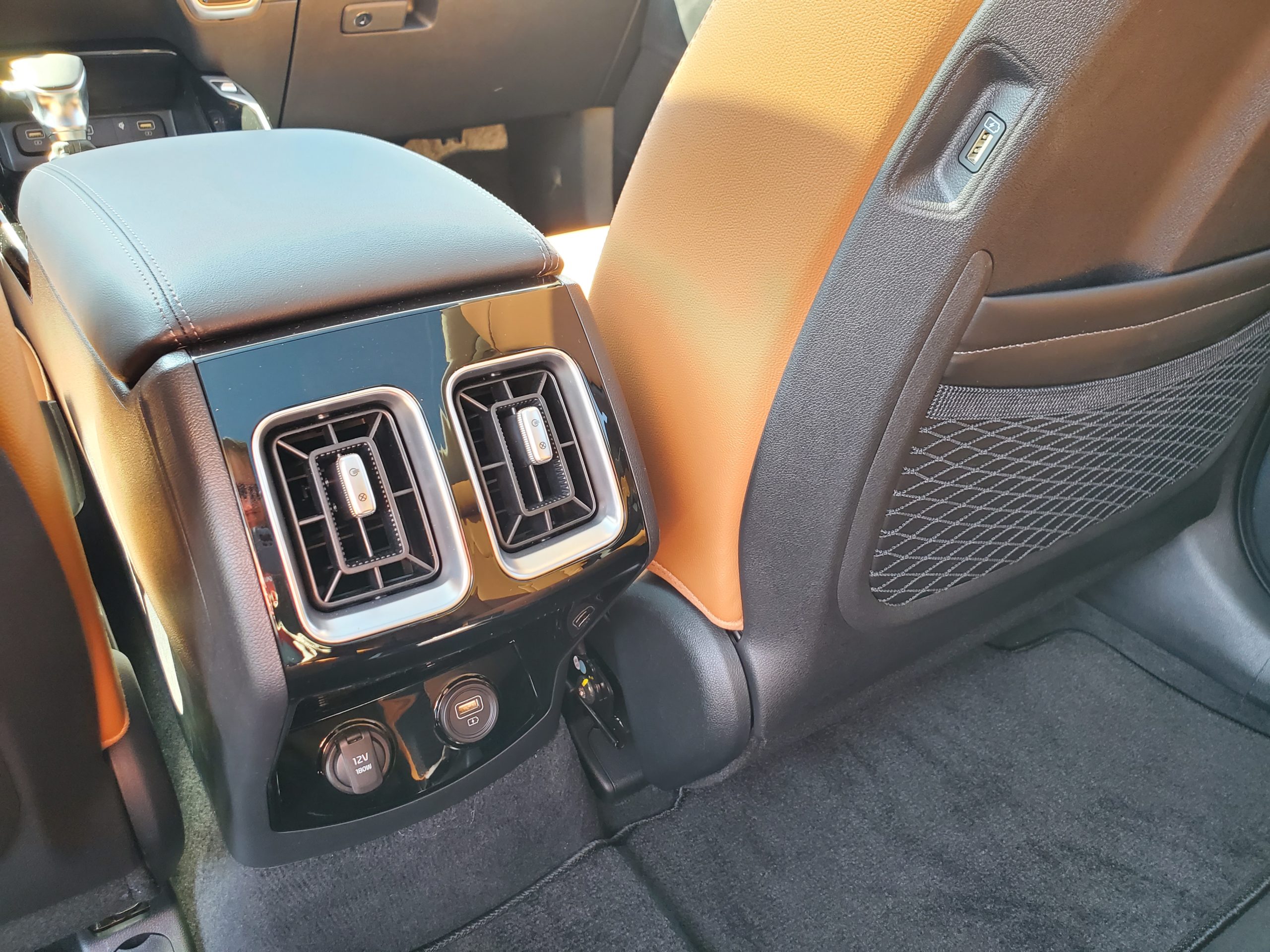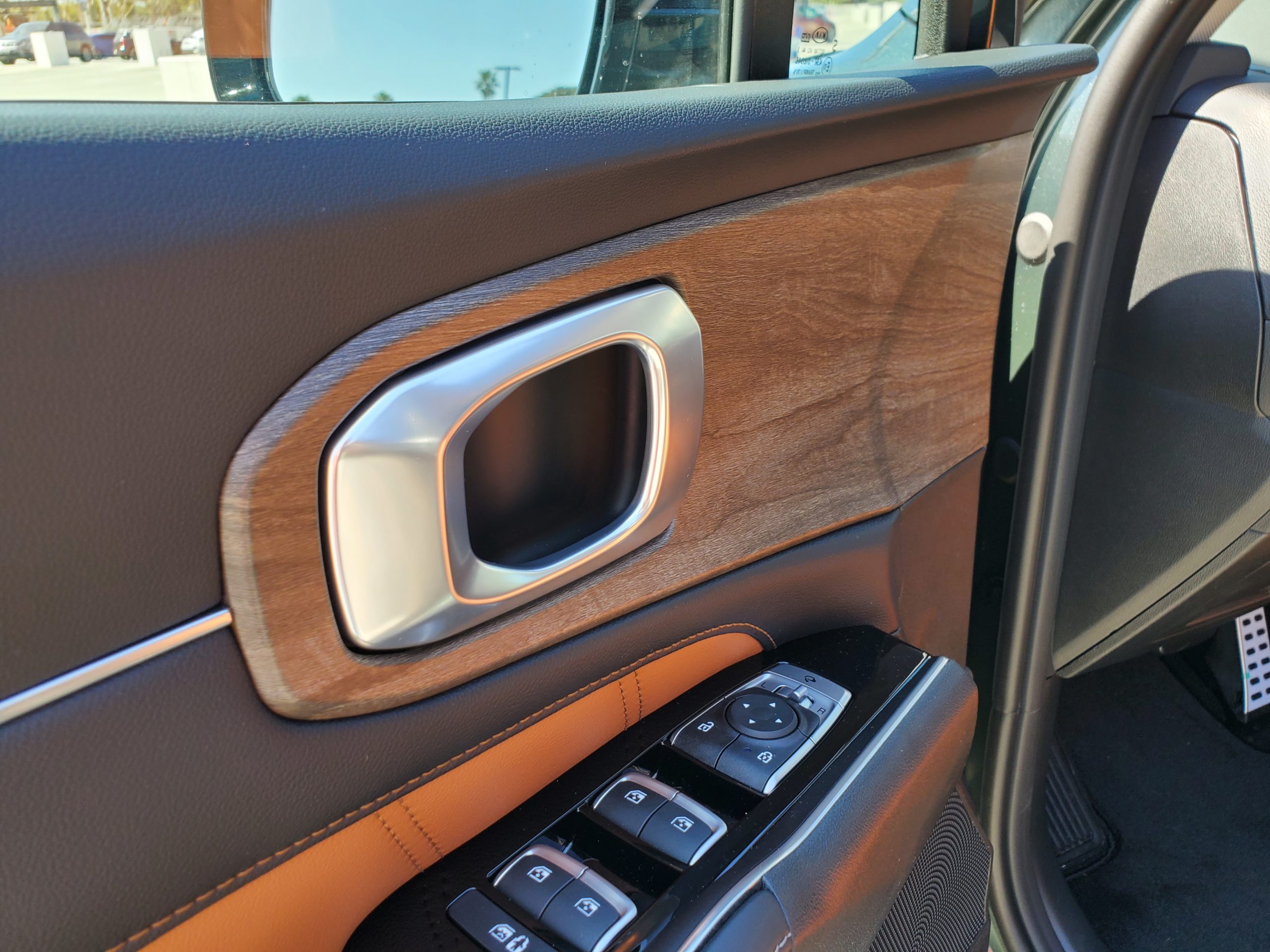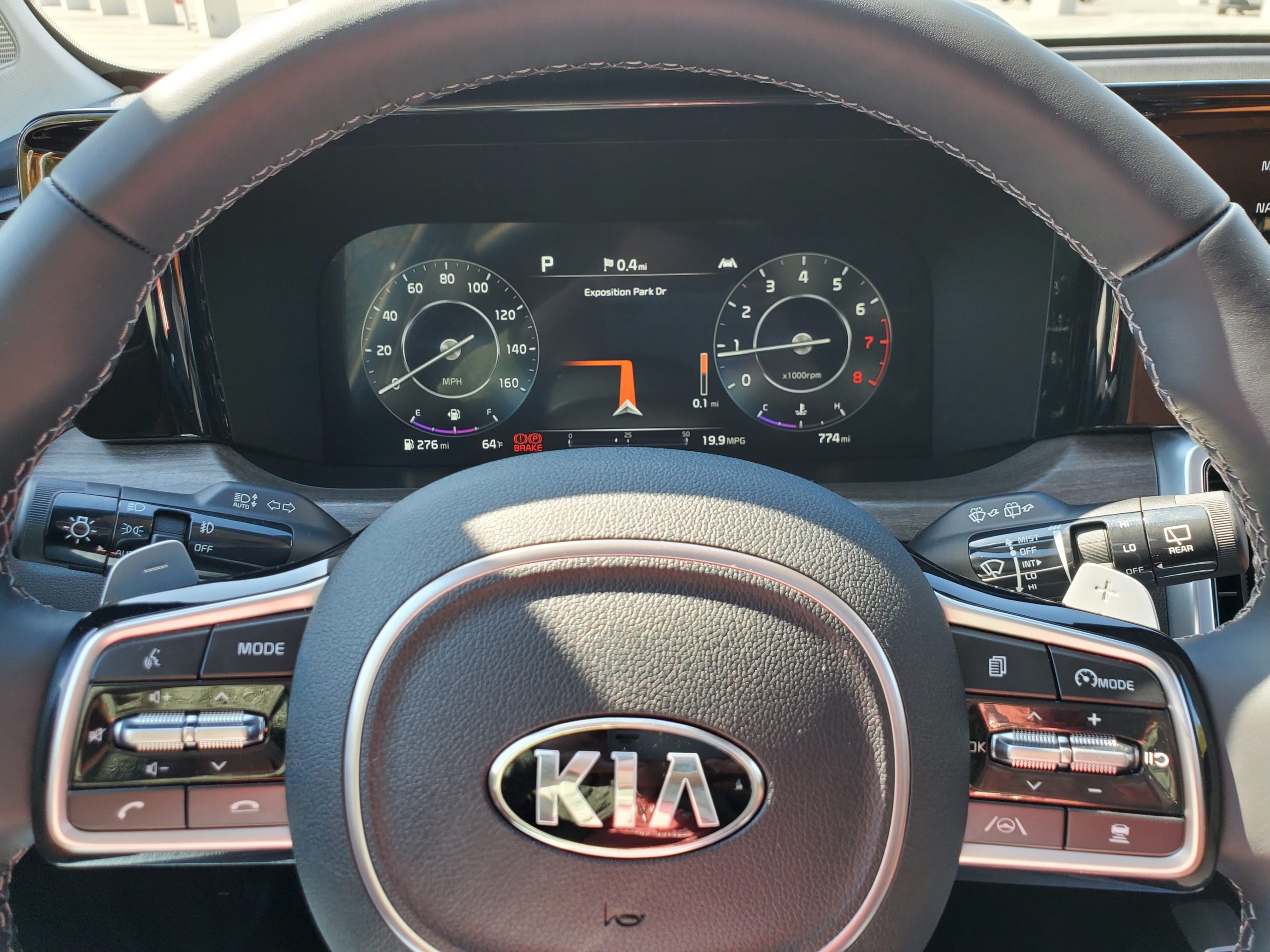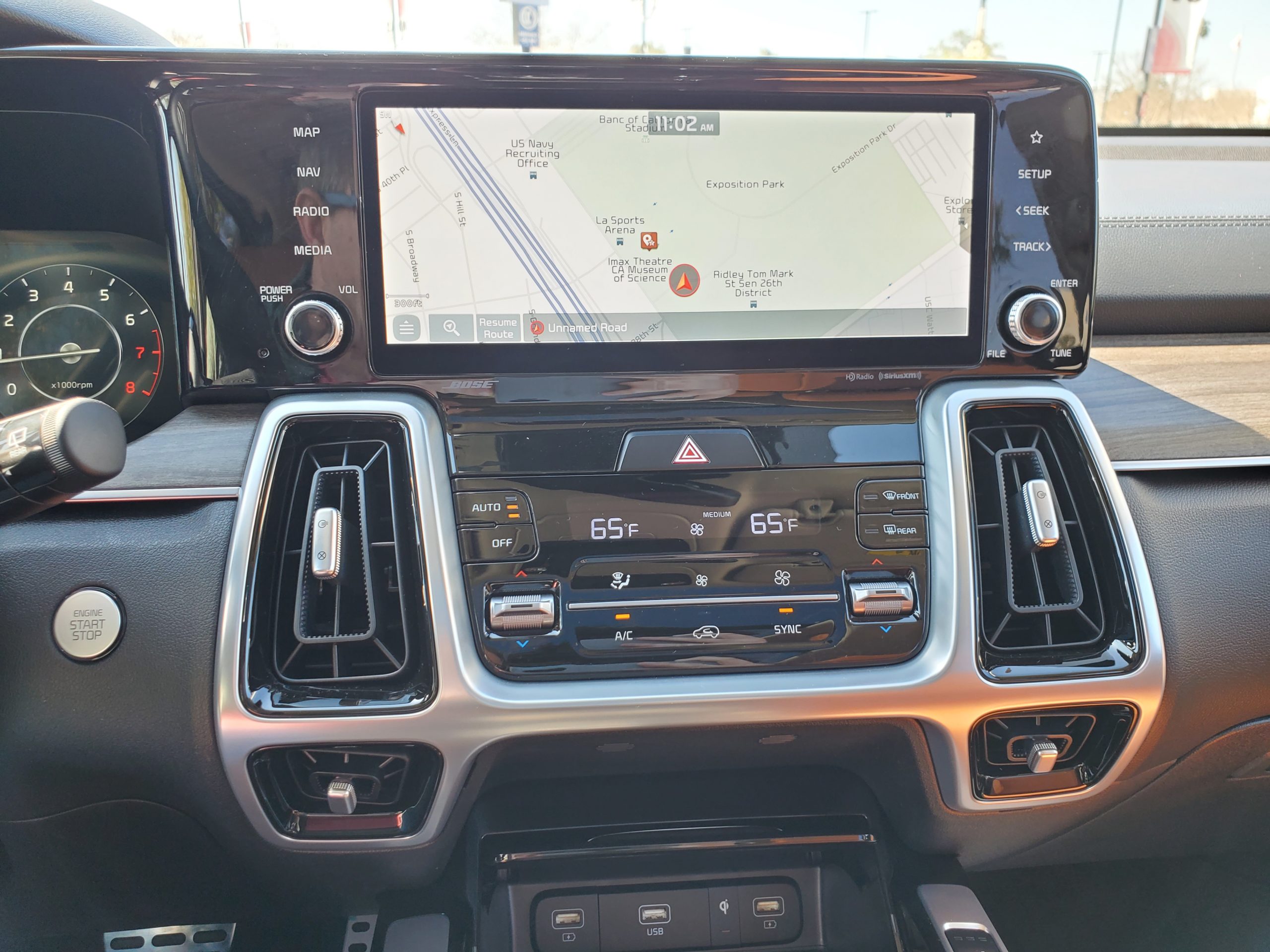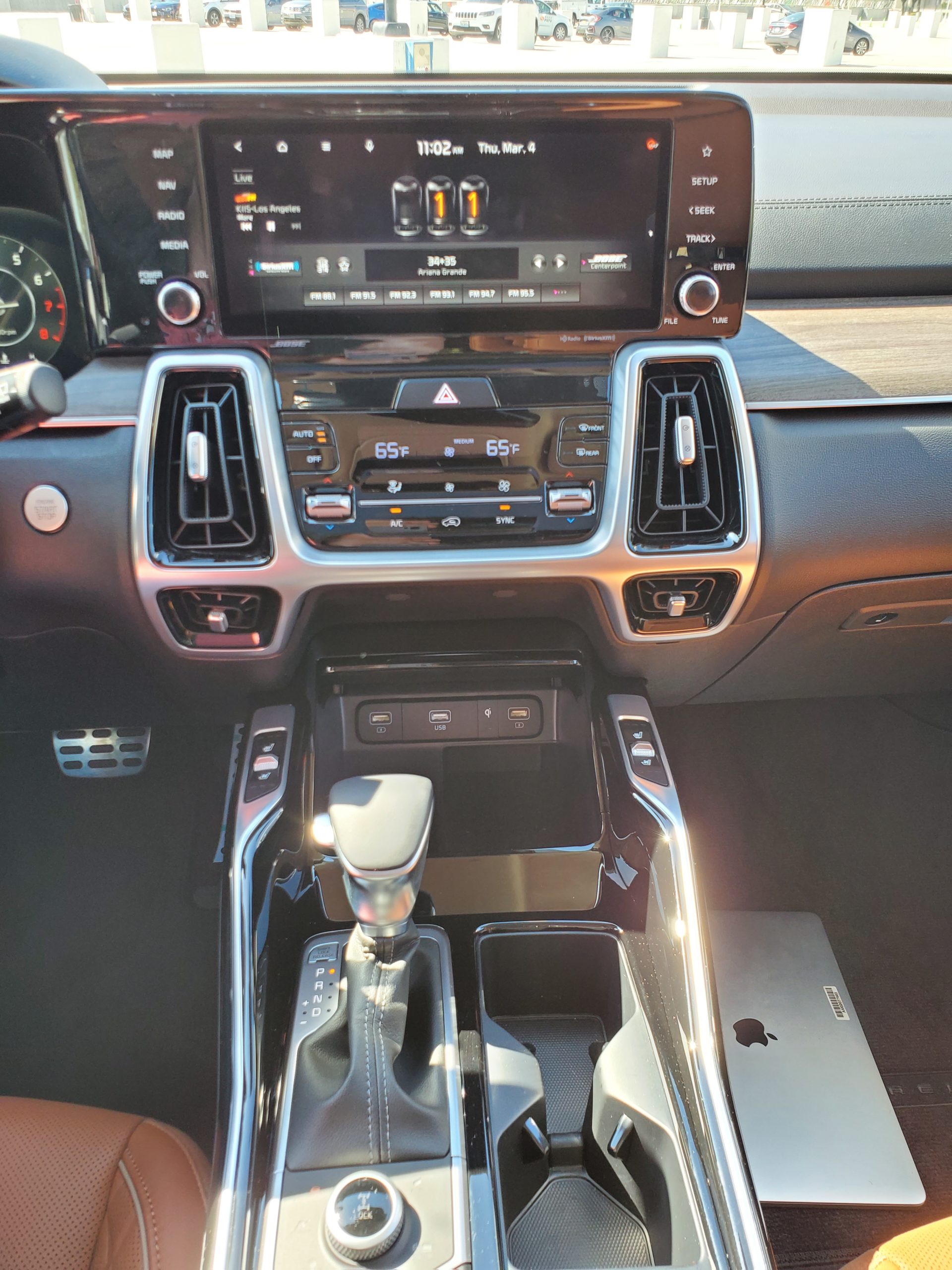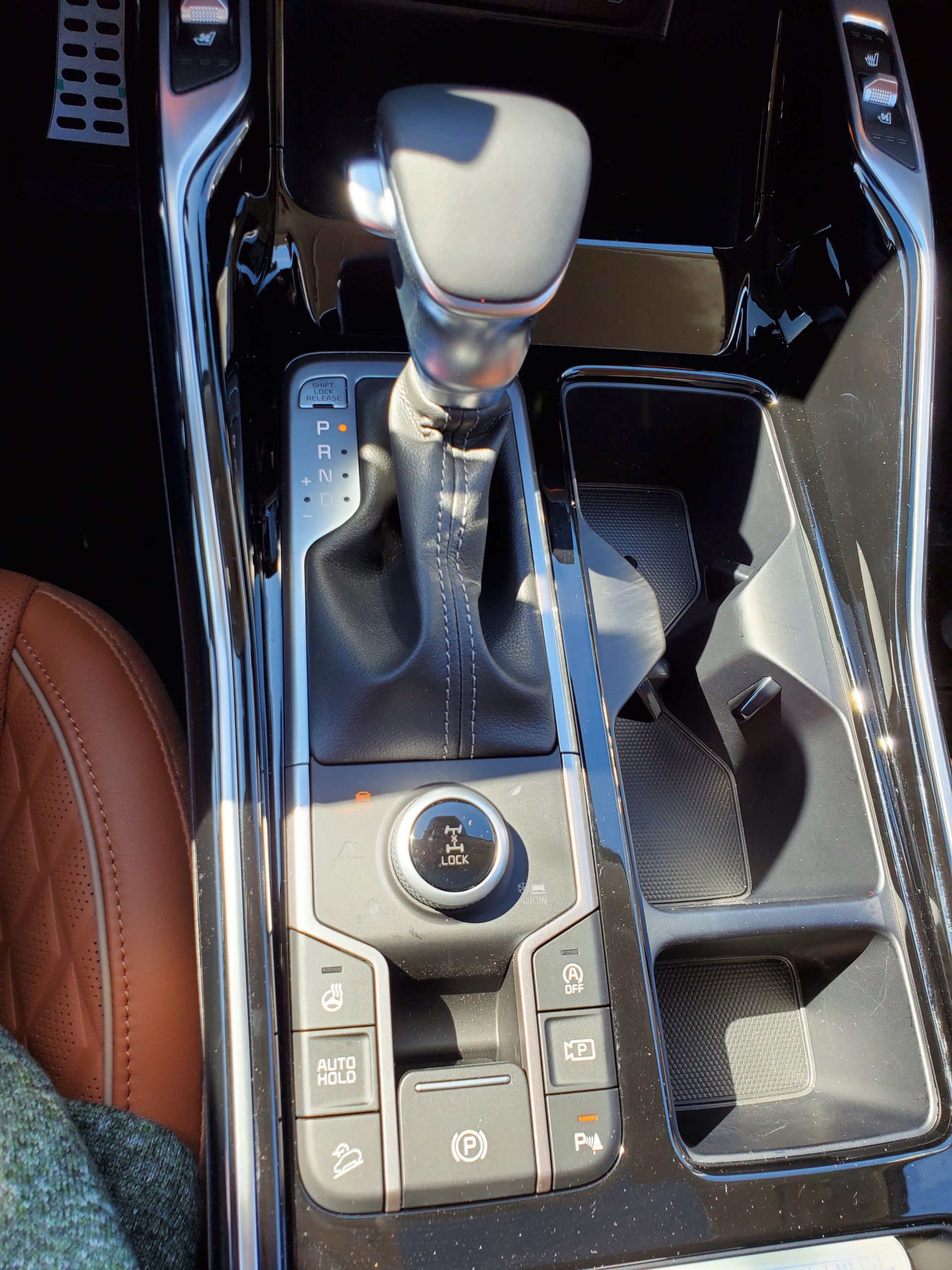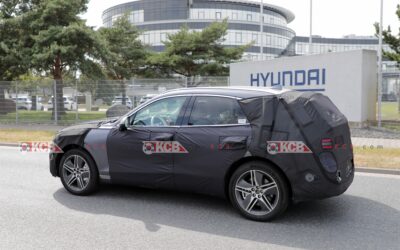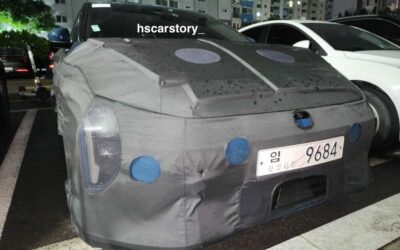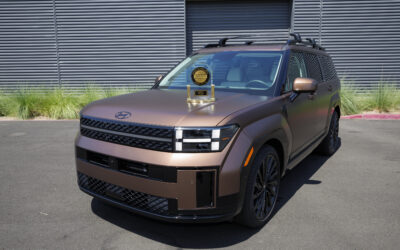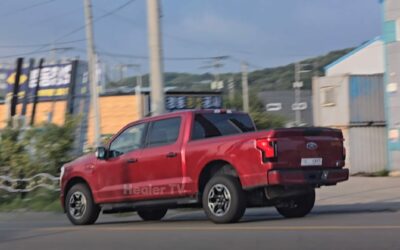I had a chance to drive the all-new US-spec 2021 Kia Sorento this past week in its top-of-the-line SX Prestige X-Line trim level. I was impressed by its attractive presence, refined ride, and luxurious appointments. However, its mid-size footprint and commitment to affordable pricing mean there are some compromises you should be aware of if you’re looking to buy this fully redesigned model of the popular Sorento crossover.
[ads id=“9”]
Exterior Styling
When I approached the new Sorento from the outside, I was immediately impressed by the subtle sophistication and rugged presence of the exterior styling. The dark yet highly metallic Aruba Green paint color is accentuated well by wheels painted in dark gray. This X-Line exclusive color combination helped the Sorento to look like a rugged and capable SUV, despite its crossover roots and capabilities. All 2021 Sorento AWD models gain an 8.2” ground clearance, which is 1.3” higher than their FWD counterparts. The X-Line package is further differentiated by unique front and rear skid plates finished in silver and more purposeful ladder-style roof rails that make it easier to tie down roof-mounted cargo.
All except base model and hybrid Sorento models receive black chrome window surrounds, which look modern and sporty, and hide the small sharkfin-shaped window trim piece on the C pillar. I’ve seen this styling cue on several recent Kia models, and it looks distinctive, but is better applied more subtly as it is here. Full LED lighting on the Sorento (SX trim and above) looks good, with white front LED daytime running lights which double as the turn signals. I’m not sure why Kia decided not to keep the daytime running lights amber at all times, since they did so with the K5 and the Telluride SX.
The Sorento’s LED taillights are distinctive and are physically split into outer brake lights and inner turn signals. The rear wiper is hidden at the top of the tailgate which allows for a clean look at the top, but heavy detail on the trim piece below the rear glass reduces that feeling as your eye moves downward. A flatter appearance in this area would improve the looks of the Sorento’s rear. The widely placed “Sorento” badge looks great at the bottom of the tailgate, but the multiple badges denoting the trim level, engine type, and AWD appear to be placed haphazardly in contrast.
[ads id=“8”]
Interior Space
The 2021 Sorento has a similar footprint to the outgoing 2020 model, with wheelbase, length, and width all around an inch difference of the outgoing model, so it’s no surprise that interior volume feels similar. What this means is that while the Sorento feels great for front seat passengers, it’s a little small when you’re trying to haul around passengers in both the second and third rows along with all their gear.
The SX Prestige X-Line I drove had the rust colored leather package with white seat piping, captain’s chairs, and faux-open-pore-wood, which when put together felt quite luxurious. Especially in the first row, the leather feels extremely comfortable. The second row captain’s chairs have the same high-quality material, but appear thinner both on the seat backs and the seat bottoms than those for the driver and front passenger. The second row captain’s chairs in this top-of-the-line specification do not offer seat heating, let alone ventilated seats like those in the Telluride’s upper trims. The armrests for those captain’s chairs are also a little narrow compared to other captain’s chairs out there.
My first impression of the captain’s chairs was that legroom was excellent in the second row and the recline angle was great for longer trips, but I realized when I squeezed into the third row that there is very little legroom for third-row occupants, and absolutely none when the second row seats are reclined. That, combined with the fact that there is no room for your feet in the third row means that your knees will be against your chest when you’re sitting in the third row, even for smaller occupants. Those second row captain’s chairs do slide fore and aft, so you can solve the legroom problem, but increasing legroom for the third row reduces legroom in the second row undesirably.
Practically speaking, this means that only small children can really survive for a long drive in the third row and that seating space will require frequent compromises between passengers. Third row occupants do get their own dedicated USB charging points, cupholders, and storage bins, and take advantage of high-quality materials in those spots that will attract fingers. However, third row passengers lose a lot of outward visibility because of the sloping side window design and the fact that the panoramic sunroof ends long before the third row starts. And while there are speakers in the back for both the radio and the passenger talk function, there are no climate vents in the third row.
Second row passengers do get climate vents, although they can’t control the temperature or fan speed. They can take advantage of multiple power ports, which include those on the back of the center console and Telluride-style USB ports on the inboard sides of the driver and passenger seats. While the center console is too narrow to offer cupholders for rear-seat occupants, Kia has mounted them on the doors, and they’re sturdy enough to take care of any sized fountain drink.
The captain’s chairs also have mechanical buttons at both the bottom and top of each seat. With a single touch of either of these, the seat folds and slides immediately, allowing good access to the rear seats. As already mentioned, the narrow dimensions of the Sorento make it difficult to squeeze back to the third row between th\e captain’s chairs. For me, the practicality of a second-row bench seat would win out over the luxurious feel of the individual captain’s chairs. Kia doesn’t give you much choice, though, as you can only get the second-row bench in the lower LX and S trim levels.
A smart power tailgate is standard on all EX and SX models and opens to reveal a trunk which is tight behind the third row, with only 12.6 cubic feet when all the seats are up. This really isn’t enough space for the gear to go along with 6 potential occupants, and will necessitate larger families to purchase a roof-mounted cargo solution to go with those beefier roof rails of the X-Line. Dropping the third row using the manual straps reveals a much more impressive amount of flat cargo space, at 45 cubic feet behind the second row. The layout of the captain’s chairs means that with the third row down, items in the cargo area could slide forward into the passenger area in the gap between the seats, so I’d advise anyone who will be carrying cargo to invest in a good cargo net.
From the cargo area, there are mechanical buttons built into the side of the trunk that allow you to further drop the captain’s chairs remotely. They fold flat and offer an impressive 75.5 cubic feet of cargo space. You’ll still need to manage the gap between those captain’s chairs, as cargo could drop into that gap while you’re driving unless you cover it with something flat.
[ads id=“8”]
Interior Amenities
The SX Prestige X-Line does get plenty of gadgets for drivers to enjoy, including a digital gauge cluster with high-res, crisp graphics. Recessed to reduce glare, Kia has taken advantage of the digital display to show additional information in the two circles of the gauges, including important vehicle information when parked and imagery from the blind spot cameras when driving and signaling. Each drive mode also enjoys its own graphics for the gauges with animations that display between modes. Because the X-Line package comes standard with all wheel drive, those drive modes include not only eco, comfort, sport, and smart modes, but also a snow mode, AWD differential lock, and a downhill assist mode.
The beautiful 10.25” center screen uses unique purple-white gradients extensively throughout the user interface. This appears a little polarizing, but I think it comes across as modern and refreshing. The infotainment system is surprisingly responsive and easy to navigate. The map shows just the right level of detail and I like how it allows zooming using the right-hand physical rotary dial. The 360-degree camera system is also extremely good. The software perfectly places your car in your surroundings on the high-resolution screen, and it definitely beats versions of this system I’ve seen in other Kia models.
I’m a little less enthusiastic about the capacitive touch buttons on either side of the screen, because sometimes you miss pressing them in the center, especially if you’re driving, and in that case they don’t register that you pressed them. They are also fingerprint traps on the gloss black plastic. Climate controls similarly use these capacitive touch buttons, but luckily only for fan speed and air direction. The temperature selection for the dual-zone system are physical switches, as are the buttons for selecting between three levels of automatic climate control (a feature I really like to avoid the air blasting out of the vents everytime you step in the car while still enabling the auto climate controls), the front and rear defrosters, and the switch to turn off the system.
I was impressed by the unique design of the climate vents for front-seat passengers. You can direct the top part of each vent towards your upper body, while directing the bottom part of in a different direction as desired. The bottom vent is also much smaller, allowing more control of the airflow. This is a really thoughtful design.
Other features I liked in the front include the wireless phone charger which lights up green when the phone is fully charged and the one-touch auto-up/down power windows for all 4 windows in the car. It’s also a great idea to have the child lock button on the driver’s door. It’s so convenient to be able to activate the rear child locks from the front seat rather than having to remember to physically activate them when the doors are open while parked. The panoramic sunroof also makes the whole car feel extremely light and airy.
A couple of things I was surprised had been left out on this top-of-the-line Sorento are a heads-up display (not available on any trim level), a sunglass holder, a garage door opener system, and a shift-by-wire transmission. I think it’s clear that Kia has had to make some hard decisions to keep pricing reasonable on high-end trims.
Click to view full size
The Driving Experience
All Sorento EX and SX models come equipped with the brilliant new 2.5 liter turbocharged inline four with 281 horsepower and 311 ft-lbs torque. It’s the same engine that’s found in the K5 GT and the Stinger GT Line. These are impressive numbers and they show when driving the car. While the Sorento is quite heavy (the one I tested was over 4,000 pounds), the 2.5T was super responsive, and while it didn’t blow me away, had plenty of straight line acceleration to get drivers where they need to go quickly. 0-60 time is an estimated 7.2 seconds. That’s definitely helped by the AWD system, and as I drove the car I could monitor which wheels were being driven at any given time in the gauge cluster. The power is pushed to each wheel via a wet type 8-speed dual clutch transmission, same as that in the K5 GT.
I thought body roll was just okay, with the Sorento performing well but not superbly on tight corners. That being said, the FWD variant with the 1.3” lower center of gravity will be a better performer in that department. I didn’t have the chance to go off-road in the new Sorento in the few hours I had with the car, but the ground clearance, approach and departure angles appear to be quite good for mild off-road tracks, and the AWD system along with its hill-descent mode and snow modes mean that it should be capable enough for most people’s day-to-day needs. However, it won’t be able to hold its own against more purpose-built vehicles like Jeep Grand Cherokee or Toyota 4Runner.
The 2021 Sorento did impress me with its adaptive cruise control system. I often find that taller vehicles like the Sorento do better in this regard, and this was no exception. Whereas in previous Kia models I have relied on the most conservative settings when using the smart cruise control, the Sorento inspired confidence even on the more aggressive settings where reactions occur later. The system kept the Sorento right in the middle of the lane at all times, even around tight corners. Previous Kia vehicles I’ve driven with this feature get too close to the lane markers for my liking. Also, when on the freeway as traffic was slowing and stopping, the car kept a good distance behind the car in front at all times, and I never felt it was leaving too big of a gap that would be filled by another driver. Unlike other Kia models I’ve driven with the aggressive settings for the smart cruise control, the car did not wait until the last possible second to slam on the brakes, and kept a safer distance at all times. Really, this is one of the best smart cruise control systems on a Kia model to date.
Pricing and Conclusion
It’s clear that Kia has taken great care to ensure that the Georgia-built Sorento is priced competitively. Including destination charges, the MSRP of the base model of the Sorento (the LX FWD) is $31,010, while the top-of-the-line SX Prestige X-Line I drove came out at $43,965. At just $13,000 more than the base price, it feels like a true value, especially compared to some of its competitors.
That being said, the Sorento is clearly a midsize crossover and it feels like one. If the third row is seeing anything beyond occasional use, passengers will have to make continuous compromises, and cargo space will be a problem. If you need to use the third row seat often, it’ll be well worth the money to upgrade to the larger Telluride, or look at the new Carnival minivan if you need even more space.
However, for those who can’t swing the Telluride’s price premium (remember to take into account those dealer markups which won’t be as big of a problem with the Sorento), the Sorento can be a good compromise. Additionally, for those who will only use the third row occasionally, the Sorento is a great choice. If you don’t need the third row at all, remember that it is standard on the Sorento, but the Hyundai Santa Fe is roughly the same size and comes only with two rows.
The 2021 Kia Sorento is a great all-around package with excellent styling, interior amenities, and high quality materials throughout, and for the price tag it is a great package. But make sure you spend some time playing around with the rear passenger and cargo configurations before you buy, to avoid discovering some of the compromises Kia has made with its perennial mid-size crossover too late.

